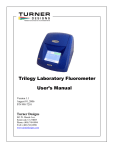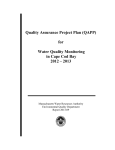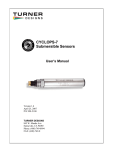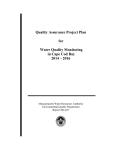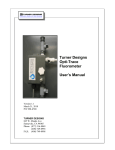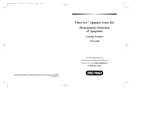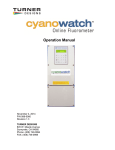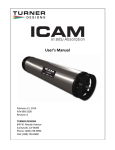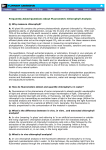Download Manual - Turner Designs
Transcript
Trilogy Laboratory Fluorometer User’s Manual Version 1.2 September 15, 2010 P/N 998-7210 Turner Designs 845 W. Maude Ave. Sunnyvale, CA 94085 Phone: (408) 749-0994 FAX: (408) 749-0998 www.turnerdesigns.com This Page Intentionally Left Blank Trilogy Fluorometer User’s Manual P/N 998-7210 Page 2 of 38 Highlights of the Trilogy Fluorometer Multifunctional, Compact and Modern Design provides flexibility and precision Sample Chamber accepts snap-in Application Modules for Fluorescence, Absorbance and Turbidity measurements Spreadsheet Interface Software provides real time display and logging of data to Excel Spreadsheet Trilogy saves time by storing up to 18 named calibrations Color Touch-Panel Graphics User Interface provides intuitive ease of use Automatically calculates and displays Extracted Chl a concentrations using filtered and solvent volumes Trilogy Fluorometer User’s Manual P/N 998-7210 Page 3 of 38 Table of Contents CHAPTER DESCRIPTION PAGE Highlights of the Trilogy Fluorometer I. Getting Started 3 5 Description Unpacking and Inspection Setup Getting to the Home Screen Precautions 5 5 6 6 7 II. Fluorometer Operation 8 Touch screen Basics (Fluorescence) Measuring Samples 8 9 III. Absorbance Operation 11 Touch Screen Basics (Absorbance) Measuring Samples 11 12 IV. Turbidity Operation 14 Touch Screen Basics (Turbidity ) Measuring Samples 15 15 V. Calibration Overview V. Calibration Overview A. B. C. D. E. F. G. H. J. K. L. M. N. 16 17 Why Calibrate When to Calibrate Trilogy Calibration Options, (Fluorescence and Turbidity) Trilogy Calibration Procedures “Direct Calibration” Procedure – a) Fluorescence and Turbidity Modules, Single Point and Multi Point Cal Extracted Chlorophyll Measurements with the Chl a – Acidification Fluorescent Module Calibrating and Displaying Corrected Readings for the Chl a Acidification and Non-Acidification Modules “Direct Calibration” Procedure – b) Extraction, Acidification, Single Point and Multi Point “Direct Calibration” Procedure – c) Extraction, Non-Acidification, Single Point and Multi Point Using the Secondary Standard Using the Solid Secondary Standard for in vivo Chlorophyll Applications Use of the Solid Secondary Standard for Dye Applications: Trilogy Calibration Procedure, (Absorbance Module) VI. Touch Screen Basics 26 Touch Screen 26 VII. Systems Connections 27 Serial Output Functional Check 27 VIII. Spreadsheet Interface Software Installation Excel Spreadsheet Example 28 28 Appendix A - Troubleshooting 29 Fluorescence Troubleshooting Absorbance Troubleshooting Turbidity Troubleshooting Spreadsheet Interface Software Troubleshooting 29 29 30 30 Appendix B - Warranty and Obtaining Service Warranty Out-of-Warranty Service 32 32 32 Appendix C – Specifications Appendix D – Principles of Fluorescence Principles of Fluorescence 33 34 34 Appendix E – Recommended Measurement Practices Linear Range and Quenching Temperature Considerations 35 35 35 Appendix F - Chlorophyll a Acidification and Non-Acidification calculations Appendix G - In vivo fluorescence measurements using Trilogy Trilogy Fluorometer User’s Manual 17 17 17 17 18 20 20 20 23 23 23 24 24 P/N 998-7210 36 37 Page 4 of 38 I. Getting Started Description The Trilogy Laboratory Fluorometer is a compact, multifunctional laboratory instrument that can be used for making fluorescence, absorbance, and turbidity measurements using the appropriate snap-in Optical Module. A color touch screen with simple menus makes for an intuitive user interface. Fluorescence Modules are available for discrete sample measurement of various fluorescent materials including chlorophyll (in vivo and extracted), rhodamine, fluorescein, cyanobacteria pigments, ammonium, CDOM, optical brighteners and other fluorescent compounds. The Absorbance Module accepts interchangeable filter paddles so measurements can be made at different wavelengths in order to identify or place a sample in a particular class of compounds. The standard filter paddle wavelengths/bandwidths are: 560/10; 600/10 and 750/10 nm. The Turbidity Module uses an Infrared (IR) LED with a wavelength of 850 nm as required for reference method: ISO 7027/DIN EN 27027, “Water Quality – Determination of Turbidity”. Using Infrared allows Turbidity to be measured at wavelengths that are not normally absorbed by organic matter thereby reducing susceptibility to interference by sample color. When properly calibrated, the Trilogy Fluorometer will read out the actual concentration of the solution. Optical Modules contain the necessary light source and filters for the relevant application Unpacking and Inspection Upon receiving the Trilogy, please inspect it carefully and make certain all accessories are present. Refer to the checklist shipped with the instrument for order-specific items. A typical Trilogy shipment includes: - Checklist - Trilogy Laboratory Fluorometer - CD – Trilogy, includes files for: User’s Manual (pdf); Quick Start Guide (pdf); Spreadsheet Interface Software (pdf) - Solid Secondary Standard, (not intended for use with UV or Turbidity optical modules) - Power Supply Kit - RS-232 Cable - Quick Start Guide, (hardcopy) - 10 x 10 mm Methacrylate Cuvettes, (quantity of 10) - 12 x 35 mm Glass Round Vial, (quantity of 5) - 12 mm Round Adaptor - 50-Well Microtube Storage Box - Optical Module(s) as ordered Fluorescence Module Absorbance Module Turbidity Module Trilogy Fluorometer User’s Manual P/N 998-7210 Page 5 of 38 Setup Place the Trilogy Fluorometer on a flat, level surface. Allow at least 6 inches (16 cm) of clearance above the instrument to open and close the lid. Position the instrument so that the touch screen faces you . Power Supply Connect the power supply into the power connection of the instrument, see Figure 1, and plug it into a wall outlet. See Specifications for power requirements. Figure 1. Getting to the Home Screen 1. With the unit turned off, lift the lid and insert an optical module into position, (see Fig 2). Then press down on the module until you hear it snap into place. Be sure to close the fluorometer lid so that the Trilogy power on step will complete successfully. 2. Turn on the On/Off switch located on the back of the Trilogy, see Figure 1. Verify the display becomes active, and shows the module selection screen, see Figure 3 – Module Selection. Figure 2 showing Optical Kit installed in preparation for getting to the Home Screen. Trilogy Fluorometer User’s Manual P/N 998-7210 Page 6 of 38 Figure 3 Module Selection Screen 3. Select the module inserted, and touch “OK” on the confirming screen. 4. When the Home Screen is displayed (Fig. 4), you are now ready to use Trilogy in its Raw Mode (measurements are relative) or calibrate the Trilogy and the snapped-in Optical Application Module to make quantitative measurements. Figure 4: Trilogy Home Screen Display for Fluorescence Module Configuration. Precautions The Trilogy is intended for indoor use only. Wipe up spills immediately. The Trilogy contains sensitive optical components and precision-aligned mechanical assemblies. Avoid rough handling. Do not leave the lid open for extended periods of time. Turn OFF the Trilogy to change or install Optical Application Modules. Note: After 20 minutes without activity or user stimulation, the Touch Screen hibernates. Lightly touch the screen to activate. Trilogy Fluorometer User’s Manual P/N 998-7210 Page 7 of 38 II. Fluorometer Operation Fluorescence Optical Module Installation 1. Power the Trilogy OFF 2. Grasp the handle of the Optical Application Module and align the kit with the sample compartment. 3. Press down firmly to lock the Optical Application Module in place. You should hear or feel a click indicating the module has snapped into place. (See Figure 5.) 4. Close the lid and power ON the Trilogy. Use the touch screen to identify the type of Optical Application Module installed. Figure 5. Removal 1. Power OFF the Trilogy before removing the Optical Application Module 2. Grasp the handle and gently pull up to release the kit from the sample compartment. Touch screen Basics (Fluorescence) Home Screen The "Home" screen appears after confirmation of the Optical Application Module. The "Home" screen provides orientation for the multiple functions of the Trilogy. From the "Home" screen, select "Calibrate," "Tools," "Mode," or "Help." The "Home" screen is also the measurement screen. (See over for Figure 6 showing Home Screen with callouts). Trilogy Fluorometer User’s Manual P/N 998-7210 Page 8 of 38 Figure 6 – Trilogy Home Screen for Fluorescence Module Configuration. Calibration Refer to Section V. Measuring Samples There are two measurement modes available on the Trilogy when using the Fluorescence Module: Raw Fluorescence Mode – No calibration required Direct Concentration Mode – Calibration required (see Section V) Touch “Mode” on the Home Screen to select the measurement mode. 1. Raw Fluorescence Mode: The Raw Fluorescence Mode should be used for qualitative measurement, relative changes in fluorescence rather than absolute concentration values. Readings are displayed in Relative Fluorescence Units (RFU). 2. Direct Concentration Mode: The Direct Concentration mode makes absolute measurements based on a calibration; see Section V for the Calibration Procedure. The Trilogy accommodates 10 x 10 mm methacrylate and polystyrene cuvettes (minimum 2 mL volume). Use 12 x 35 mm or 12 x 75 mm glass test tubes for measuring solvent applications, such as extracted chlorophyll, and use methacrylate cuvettes for UV water applications. 1. Open the lid of the Trilogy and insert the cuvette. Close the lid. Trilogy Fluorometer User’s Manual P/N 998-7210 Page 9 of 38 2. Touch "Sample ID" to name your sample (optional). 3. Using the keypad, enter the sample name into the name field and touch "Save" to save the sample ID. 4. Touch "Measure Fluorescence" to make a measurement. The Trilogy will measure the sample for 6 seconds and report the average reading for the sample. The Trilogy reports data on the "Home" screen and displays the results for the most recent 20 measurements. Use the arrow keys to scroll through the most recent measurements. The data automatically exports to a printer or PC when properly connected, (see Section VII). Please note the Trilogy does not store more than 20 measurements at one time. If more than 20 readings are taken, the oldest reading will be overwritten. Measurements are not stored between power cycles. Tools (Fluorescence) Touch the “Tools” key to access "Settings." Tools - Settings View Cal Details Touch "View Cal Details" to see information on the current calibration for Direct Concentration Mode. "View Cal Details" specifically provides information on the raw fluorescence for each standard and the blank as well as the unit of measure and the Optical Application Module. Continuous Sampling The Continuous Sampling feature enables repeat measurements at user-defined intervals. 1. Touch "Continuous Sampling" and turn the feature ON. Highlight the frequency of measurement and the number of total measurements. The maximum number of total measurements is 9999. 2. Touch "OK" to return to the "Home" screen. 3. Connect the Trilogy to a printer or a PC to collect the data. Touching the screen repeatedly causes an early-abort of Continuous Sampling measurements. Measurement Tip: On the Home Screen, touch Settings then touch the Lid Start key to turn the feature ON. When the Lid Start feature is ON, measurement begins as soon as the lid closes. The lid start feature allows for immediate measurement and eliminates the need to touch the "Measure" key. Also, the touch screen does not hibernate when Lid Start is ON. Return to the Lid Start key under the Settings menu to turn the feature OFF. Trilogy Fluorometer User’s Manual P/N 998-7210 Page 10 of 38 III. Absorbance Operation Absorbance Module Installation 1. Power OFF the Trilogy. 2. Align the Absorbance Module with the sample compartment. 3. Press down to lock the Absorbance Module in place. You should hear or feel a click indicating the module has snapped into place. 4. Close the lid and power ON the Trilogy. Select "Absorbance" from the list of options on the touch screen. 5. Install the filter paddle that corresponds to the wavelength of absorbance for the assay. (See Figure 7.) Figure 7. Removal 1. Power OFF the Trilogy before removing the Absorbance Module. 2. Grasp the handle and gently pull up to release it from the sample compartment. 3. Close the lid to protect the light detector from exposure to ambient light. Alternatively, install an Optical Application Module. Touch Screen Basics (Absorbance) Home Screen The "Home" screen appears after confirming the photometer operation by installing the Absorbance Module. From the "Home" screen, select "Calibrate," "Tools," "Mode" or "Help." The "Home" screen is also the measurement screen. (see Figure 8 on next page) Trilogy Fluorometer User’s Manual P/N 998-7210 Page 11 of 38 Mode Touch "Mode" to select the unit of measure for absorbance. The available options include Absorbance units (Ab) and Transmittance (%T). The following formulas describe the method of the Trilogy Absorbance Module for measuring % transmittance and absorbance: %T = [(s-z) / (b-z)] * 100 Ab = 2 - Log10 * (%T) Where, z = zero b = baseline s = signal Figure 8: Home Screen When Using Absorbance Module Calibration See Section V. Measuring Samples The Absorbance Module accommodates 10 x 10 mm methacrylate and polystyrene cuvettes as well as glass cuvettes (minimum 2 mL volume). 1. Open the lid and insert the cuvette. Close the lid. 2. Touch "Sample ID" to name your sample (optional). Using the keypad, enter the sample name into the name field and touch "Save" to save the sample ID. 3. Touch "Measure Absorbance" to make a measurement. The Trilogy will measure the sample for 6 seconds and report the average reading for the sample. Trilogy Fluorometer User’s Manual P/N 998-7210 Page 12 of 38 The Trilogy reports data on the "Home" screen and displays the results for the most recent 20 measurements. Use the arrow keys to scroll through the most recent measurements. The data exports to a printer or PC if properly connected, (see Section VII). Please note the Trilogy does not store more than 20 measurements at one time. If more than 20 readings are taken, the oldest reading will be overwritten. Measurements are not stored between power cycles. Tools - Settings Touch the "Tools" key to access "Settings." View Cal Details Touch "View Cal Details" to see information on the current calibration for the baseline and the zero. Continuous Sampling The Continuous Sampling feature enables repeat measurements at user-defined intervals. 1. Touch "Continuous Sampling" and turn the feature ON. 2. Highlight the frequency of measurement and the number of total measurements. The maximum number of total measurements is 9999. 3. Touch "OK" to return to the "Home" screen. 4. Connect the Trilogy to a printer or a PC to collect the data obtained during Continuous Sampling. Touching the screen repeatedly causes an early-abort of Continuous Sampling measurements. Measurement Tip: On the Home Screen, touch Settings then touch the Lid Start key to turn the feature ON. When the Lid Start feature is ON, measurement begins as soon as the lid closes. The lid start feature allows for immediate measurement and eliminates the need to touch the "Measure" key. Also, the touch screen does not hibernate when Lid Start is ON. Return to the Lid Start key under the Settings menu to turn the feature OFF. Trilogy Fluorometer User’s Manual P/N 998-7210 Page 13 of 38 IV. Turbidity Operation Turbidity Optical Module Installation 1. Power the Trilogy OFF 2. Grasp the handle of the Optical Application Module and align the kit with the sample compartment. 3. Press down firmly to lock the Optical Application Module in place. You will hear or feel a click indicating the module has snapped into place. (See Figure 9.) 4. Close the lid and power ON the Trilogy. Use the touch screen to identify the type of Optical Application Module installed. Figure 9. Removal 1. Power OFF the Trilogy before removing the Optical Application Module 2. Grasp the handle and gently pull up to release the kit from the sample compartment. Touch Screen Basics See next page Trilogy Fluorometer User’s Manual P/N 998-7210 Page 14 of 38 Touch Screen Basics (Turbidity ) Home Screen The "Home" screen appears after confirmation of the Optical Application Module. The "Home" screen provides orientation for the multiple functions of the Trilogy. From the "Home" screen, select "Calibrate," "Tools," "Mode," or "Help." The "Home" screen is also the measurement screen. Figure 10: Home Screen When Using Turbidity Module Calibration Refer to Section V. Measuring Samples There are two measurement modes available on the Trilogy when using the Turbidity Module: Raw Mode – No calibration required Direct Concentration Mode – Calibration required – See Section V Touch “Mode” on the Home Screen to select the measurement mode. 1. Raw Mode: The Raw Mode should be used for qualitative measurement, relative changes in fluorescence rather than absolute concentration values. Readings are displayed in Relative Fluorescence Units (RFU). Trilogy Fluorometer User’s Manual P/N 998-7210 Page 15 of 38 2. Direct Concentration Mode: The Direct Concentration mode makes absolute measurements based on a calibration. Readings are displayed in Nephelometric Turbidity Units (NTU). (see Section V for the Calibration Procedure) Use polystyrene cuvettes for measuring turbidity. 1. Open the lid of the Trilogy and insert the cuvette. Close the lid. 2. Touch "Sample ID" to name your sample (optional). 3. Using the keypad, enter the sample name into the name field and touch "Save" to save the sample ID. 4. Touch "Measure Turbidity" to make a measurement. The Trilogy will measure the sample for 6 seconds and report the average reading for the sample. The Trilogy reports data on the "Home" screen and displays the results for the most recent 20 measurements. Use the arrow keys to scroll through the most recent measurements. The data automatically exports to a printer or PC when properly connected, (see Section VII). Please note the Trilogy does not store more than 20 measurements at one time. If more than 20 readings are taken, the oldest reading will be overwritten. Measurements are not stored between power cycles. Tools (Turbidity) Touch the “Tools” key to access "Settings." Tools - Settings View Cal Details Touch "View Cal Details" to see information on the current calibration for Direct Concentration Mode. "View Cal Details" specifically provides information on the raw fluorescence for each standard and the blank as well as the unit of measure and the Optical Application Module. Continuous Sampling The Continuous Sampling feature enables repeat measurements at user-defined intervals. 1. Touch "Continuous Sampling" and turn the feature ON. Highlight the frequency of measurement and the number of total measurements. The maximum number of total measurements is 9999. 2. Touch "OK" to return to the "Home" screen. 3. Connect the Trilogy to a printer or a PC to collect the data. Touching the screen repeatedly causes an early-abort of Continuous Sampling measurements. Measurement Tip: On the Home Screen, touch Settings then touch the Lid Start key to turn the feature ON. When the Lid Start feature is ON, measurement begins as soon as the lid closes. The lid start feature allows for immediate measurement and eliminates the need to touch the "Measure" key. Also, the touch screen does not hibernate when Lid Start is ON. Return to the Lid Start key under the Settings menu to turn the feature OFF. Trilogy Fluorometer User’s Manual P/N 998-7210 Page 16 of 38 V. Calibration Overview A. Why Calibrate When calibrated, the Trilogy converts the fluorescence signal to concentration units based on the standard(s) used for the calibration. This saves you from having to perform any calculations. B. When to Calibrate - For greatest accuracy, calibrate or check the calibration using a secondary solid standard before running a new batch of samples. Recalibrate if the ambient temperature changes by +/- 10°C. Recalibrate after changing Optical Application Modules or if you make measurements on a new analyte. Verify the need to calibrate by reading a stable, known concentration standard immediately after calibration and again every few hours to see if readings have changed significantly. Recalibrate when the accuracy becomes unacceptable for your study. C. Trilogy Calibration Options, (Fluorescence and Turbidity) There are two measurement modes available on the Trilogy when using either the Fluorescence or Turbidity Modules, (see section K for Absorbance Module Calibration Procedure): Raw Fluorescence Mode – No calibration required Direct Concentration Mode – Calibration required 1. Raw Fluorescence Mode: The Raw Fluorescence Mode should be used for qualitative measurement, relative changes in fluorescence rather than absolute concentration values. Readings are displayed in Relative Fluorescence Units (RFU). 2. Direct Concentration Calibration: Direct Concentrations can be calibrated by using single or multi-point calibrations. In multi-point calibrations, up to five standards and a blank can be read generating a calibration curve for increased accuracy. The software uses these points to calculate direct concentrations. The Trilogy will display the actual concentration of your samples in units that were chosen during calibration. D. Trilogy Calibration Procedures 1. Raw Fluorescence Mode: A calibration is not necessary to measure fluorescence with the Trilogy. Simply use the Raw Fluorescence Mode to obtain the fluorescence value of a sample in Relative Fluorescence Units (RFU). Use a standard curve to determine the concentration of the analyte in the samples. The Trilogy does not manipulate data while operating in the Raw Fluorescence Mode. It is not necessary to zero the Trilogy for use in the Raw Fluorescence Mode; however a blank sample should be run to determine background fluorescence. A solid secondary standard may be used to verify instrument stability and function (see section J). 2. Direct Calibration Mode: The Direct Concentration Mode requires a calibration with one blank solution and at least one standard solution. The following procedure applies to all the fluorescence modules with the exception of the Chl Acidification and Non-Acidification modules. (There are separate procedures for these two exceptions). The procedure requires the use of at least one calibration standard, (Fluorescein, Rhodamine WT, etc.). Up to 5 standard solutions can be used for a Multi Point Calibration. Calibrations can be given a name and stored for future use. Trilogy Fluorometer User’s Manual P/N 998-7210 Page 17 of 38 E. “Direct Calibration” Procedure – a) Fluorescence and Turbidity Modules, Single Point and Multi Point Cal The following procedure applies to Trilogy and the Fluorescence or Turbidity Modules. See page 20 for procedures to calibrate the Chl Acidification and Non-Acidification Modules. Instructions a) Sample Screen Turn on the Trilogy b) Select the module/application to be calibrated and confirm by touching “OK”. Note: Refer to the module label to confirm which module is in use. c) On the home screen, touch "Calibrate" to begin a calibration sequence d) Select “Run New Calibration” e) Select the unit of measurement f) Insert the calibration “blank” and touch “OK” Trilogy Fluorometer User’s Manual P/N 998-7210 Page 18 of 38 g) Enter the concentration for the first Standard. If using the Turner Designs Chlorophyll a Standard, this will be the concentration data supplied with the Standard. If doing multi point calibrations, be sure to use Standards in order of increasing concentration. h) Follow the screen prompt indicating that the standard should be inserted, touch OK i) After the calibration is complete, either select “Proceed with Current Calibration” or select “Enter More Standards”, in which case, return to “g” above. j) Name and Save the calibration for future use (optional). k) Subsequent readings in the Direct Concentration mode should reflect the actual concentration of the analyte. l) Confirm successful completion of the calibration by measuring the same Standard. The displayed concentration should equal the value used in step “g” above. Optionally, the Solid Secondary Standard could now be adjusted to give the same reading for future calibrations, see Section K. Trilogy Fluorometer User’s Manual This completes the “Direct Calibration” Procedure for the Fluorescence and Turbidity Modules. P/N 998-7210 Page 19 of 38 F. Extracted Chlorophyll Measurements with the Chl a – Acidification Fluorescent Module EPA Method 445.0 is a standard method for measuring extracted chlorophyll a and pheophytin a in marine and fresh water algae by fluorescence. It requires extraction with 90% acetone, measurements before and after acidification and some fairly simple calculations to arrive at the chlorophyll a and pheophytin concentrations (see appendix F). Method 445.0 is detailed and straightforward. (If high concentrations of pure chlorophyll b are present, see the next paragraph). A known concentration of pure chlorophyll a (as a standard) is required at least the first time you calibrate Trilogy. For greatest accuracy however, we recommend that you periodically (once every few months) use a known concentration of pure chlorophyll a in 90% acetone to recalibrate your instrument. (Liquid Primary and Solid Secondary Chlorophyll a standards are available from Turner Designs). G. Calibrating and Displaying Corrected Readings for the Chl a Acidification and Non-Acidification Modules The Trilogy software can correct displayed chlorophyll readings for filtered and solvent volumes used during the calibration and measurement cycles. Be sure to touch either “Chl A” or “Chl NA” selections in the module selection screen so that the appropriate corrections are applied to measured data. This results in displayed readings that correspond to the actual sample concentration. H. “Direct Calibration” Procedure – b) Extraction, Acidification, Single Point and Multi Point Instructions a) Sample Screen Turn on the Trilogy b) Touch “Chl – A” to select the Chlorophyll a Acidification module and confirm by touching “OK” c) On the home screen, touch "Calibrate" to begin a calibration sequence Trilogy Fluorometer User’s Manual P/N 998-7210 Page 20 of 38 d) Select “Run New Calibration” e) Select the unit of measurement f) Insert calibration “blank” and touch “OK” g) Enter the concentration for the first Standard. If using the Turner Designs Chlorophyll a Standard, this will be the concentration data supplied with the Standard. If doing multi point calibrations, be sure to use Standards in order of increasing concentration. h) Follow the screen prompt indicating that the Standard before Acidification (Fb) should be inserted. Insert sample and touch “OK”. i) Now insert the Standard after Acidification and touch “OK”. The (Fa) value will be measured and the ratio of the two readings will be displayed as seen in the next step. Trilogy Fluorometer User’s Manual P/N 998-7210 Page 21 of 38 j) If the ratio is within the required range, touch “OK”. The ratio will be stored in the Trilogy for use in the EPA Method 445.0 for measurement of chlorophyll a and pheophytin a in water. k) After the calibration is complete, either select “Proceed with Current Calibration” or select “Enter More Standards”, in which case, return to “g” above. l) Name and Save the calibration for future use (optional). m) It is recommended that the Solid Standard is now measured and the displayed value noted to enable a quick calibration check prior to later use. This completes the “Direct Calibration” Procedure – b) Extraction, Acidification, Single Point and Multi Point Trilogy Fluorometer User’s Manual P/N 998-7210 Page 22 of 38 I. J. “Direct Calibration” Procedure – c) Extraction, Non-Acidification, Single Point and Multi Point The Welschmeyer method is a simplified way to measure chlorophyll a without the need for acidification. It accurately measures chlorophyll a even in the presence of chlorophyll b and pheophytin. However, you cannot obtain a pheophytin a measurement with this procedure. Using this method, you extract your samples according to EPA Method 445.0, but skip the acidification step. You still need to calibrate the instrument the first time using a known concentration of pure chlorophyll a in 90% acetone. The calibration procedure for the Chlorophyll Non-Acidification follows the same steps as for the “Direct Calibration” mode, see Section E, however the measurement procedure will prompt for the filtered and solvent volumes. K. Using the Secondary Standard The following section will describe how to use the Solid Secondary Standard, P/No. 8000-952, with most of the Trilogy fluorescence modules, (Chlorophyll a, Rhodamine WT, etc., but not UV or Turbidity modules). The two main benefits of using the Solid Secondary Standard are: 1) It can be used in place of a primary liquid standard once a correlation between a primary standard and the solid standard has been established. 2) It can be used to check the fluorometer stability, and/or check for loss in sensitivity resulting from instrument/optical module problems. Figure 11. The Adjustable Secondary Standard includes a fluorescent rod that provides an extremely stable signal. The Solid Secondary Standard provides a very stable fluorescent signal. It has an adjustment screw so that you can tune the Solid Standard to provide a signal to match a specific sample. It should be noted that each Solid Standard/Fluorometer relationship is unique. This means that a given Solid Standard can not be used to calibrate multiple fluorometers or modules for identical readings of a given solution. L. Using the Solid Secondary Standard for in vivo Chlorophyll Applications 1. To establish a correlation between a known chlorophyll concentration and the fluorometer reading, measure a sample containing algae and note the fluorometer reading. 2. Insert the Solid Standard in the Optical Module, and adjust the Solid Standard to produce the same reading on the fluorometer as in step 1, (turning the Secondary Standard adjustment screw clockwise produces a lower signal). 3. Next, perform a chlorophyll extraction using the Trilogy Laboratory Fluorometer, Spectrophotometer or HPLC to determine the actual chlorophyll a concentration in the sample1. This will provide the correlation between the solid standard and the actual chlorophyll a concentration. 1 Information on doing a chlorophyll extraction can be found on the Turner Designs web site at this URL: http://www.turnerdesigns.com/t2/doc/appnotes/998_9000.html Trilogy Fluorometer User’s Manual P/N 998-7210 Page 23 of 38 4. Now, at any time, the Solid Standard can be used to check/establish a new correlation between a known equivalent concentration and the current Trilogy reading. M. Use of the Solid Secondary Standard for Dye Applications: The Solid Secondary Standard accessory can also be used to check the fluorometer’s stability for dye tracing applications. If necessary, the Solid Standard can be used to establish a new correlation factor without the need to use a calibration solution each time. 1. To use the Solid Standard to establish a correlation between a known dye concentration and the fluorometer reading, measure a dye solution of known concentration, say 50 ppb, and note the Trilogy reading. 2. Place the Solid Standard in the Optical Module, and turn the adjustment screw to produce the same displayed concentration as in step 1, (turning the secondary standard adjustment screw clockwise reduces the displayed concentration). Comprehensive information on dye trace measurements can be found at the following Turner Designs URL: http://www.turnerdesigns.com/t2/doc/appnotes/main.html#fluorescent N. Trilogy Calibration Procedure, (Absorbance Module) Calibrate the Trilogy after powering up, and after changing filters. For best results, calibrate the Trilogy and Absorbance Optical Module immediately before reading a series of samples. Instructions a) Sample Screen Turn on the Trilogy b) Touch “Absorbance” to select the Absorbance Application Module and calibration firmware, and confirm by touching “OK” c) On the home screen, touch "Calibrate" to update the blank Trilogy Fluorometer User’s Manual P/N 998-7210 Page 24 of 38 d) Insert a sample cuvette containing your blank sample and touch “OK” to complete the calibration update. e) When the blanking is complete, the display will revert to the Absorbance Home/ Measurement Screen. f) This completes the Absorbance calibration procedure, and the Trilogy is now ready to make Absorbance measurements. Trilogy Fluorometer User’s Manual P/N 998-7210 Page 25 of 38 VI. Touch Screen Basics Touch Screen The touch screen provides a user-friendly method to operate the Trilogy. The touch screen is sensitive to the light pressure of a fingertip. It is not necessary to use a stylus. After 20 minutes without activity or user stimulation, the touch screen hibernates. Lightly touch the screen once to reactivate. To select a function, touch the button corresponding to the function once. Tools Touch the "Tools" key to access "Settings" and "Diagnostics." Settings Contrast Touch the "Contrast" key to increase or decrease the brightness of the touch screen and enhance visibility. The arrows increase or decrease contrast. Touch the "Home" key to save the adjustment and return to the "Home" screen. Reset The "Reset" button restarts the Trilogy. Normal operation does not require this feature. The Reset feature erases data displayed on the "Home" screen. Lid Start Touch the "Lid Start" key to turn the feature ON. While the Lid Start feature is ON, measurement begins as soon as the lid closes and the touch screen does not hibernate. The Lid Start feature allows for immediate measurement and eliminates the need to touch the "Measure" key. Return to the Lid Start key under the "Settings" menu to turn the feature OFF. Diagnostics Touch Screen Calibration The "Diagnostics" menu contains a method for screen calibration. Although the touch screen is calibrated at the factory, it may need re-calibration over time. Device Configuration The "Device Configuration" key contains useful information on firmware revisions and instrument setup. General Please note the Trilogy does not store more than 20 measurements at one time. Measurements are not stored between power cycles. Trilogy Fluorometer User’s Manual P/N 998-7210 Page 26 of 38 VII. Systems Connections Establish a connection between the Trilogy and a PC or a printer to export data. Connect the 9pin RS-232 serial cable between the Trilogy and the PC or printer. The male 9-pin connector attaches to the Trilogy and the female connector attaches to the PC. Serial Output Functional Check To perform a functional check on the Trilogy Serial Output, complete the above for the Trilogy, and then complete the following steps (note that the Serial Interface Software is not required): 1. Connect the Trilogy Serial Port to the PC Serial Port. 2. To receive ASCII data from the Trilogy, open a HyperTerminal program or some other appropriate data logging software on the PC. 3. Open a connection in HyperTerminal with the following COM Port settings: Baud Rate: Data Bits: Parity: Stop Bits: Flow Control: 9600 8 None 1 None 4. Make a measurement with the Trilogy 5. At the completion of the measurement, the concentration value will be displayed on the Trilogy display window, and also displayed in the HyperTerminal window. This completes the Functional Check of the Trilogy Serial output. If you successfully completed these steps, the Trilogy Serial Output is functioning. If you were not able to complete these steps, refer to the troubleshooting section of this manual. Trilogy Fluorometer User’s Manual P/N 998-7210 Page 27 of 38 VIII. Spreadsheet Interface Software Installation Install the Spreadsheet Interface Software (SIS) to send data to an Excel spreadsheet. The Spreadsheet Interface Software requires a PC loaded with Windows '98 or higher, an available serial port, and Excel. Insert the software CD-ROM into the CD-ROM drive of the PC to initiate the installation program. After the installation is complete, an icon for the SIS appears on the PC desktop and in the "Programs" menu. (Make sure no other program on the PC is already using COM 1). Figure12: Spreadsheet Interface Software status window showing communications are set up on COM 1, and that the data will be displayed in an EXCEL spreadsheet Excel Spreadsheet Example Turner Designs SAMPLE-001 SAMPLE-002 SAMPLE-003 SAMPLE-004 426.73 RFU 24.57 RFU 35.49 RFU 2.56 RFU Trilogy Fluorometer User’s Manual P/N 998-7210 Page 28 of 38 Appendix A - Troubleshooting Fluorescence Troubleshooting Symptom Bad calibration error message Erratic reading Negative values Low readings High background Possible Solution A bad calibration error message may occur if the blank is brighter than the standard. Compare the reading of the standard and the blank in the Raw mode. When direct fluorescence readings do not produce expected values, review the standard value entered during the calibration. The number of the standard value should correspond to the actual concentration of the standard. After calibration, the blank value is automatically subtracted from subsequent readings. A negative reading can occur if a sample reading is less than the blank. This may also indicate that the module is not properly snapped into place. Press down on the module and listen for a click indicating the module has properly been installed. Check the excitation and emission wavelengths of the analyte against the specifications of the Fluorescence Optical Application Module in use. Different analytes require different Optical Application Modules. A wet cuvette or spill could contaminate the cuvette holder and increase the background signal. Carefully clean the cuvette holder with 70% ethanol Absorbance Troubleshooting Symptom Non-linear response Low readings Bad Calibration Error Message Possible Solution Many absorbance assays do not produce a linear response but instead produce a sigmoidal or pseudo-sigmoidal response. Refer to the Application Note for the assay for more information. Check the filter installed in the Absorbance Module and make sure it is the correct filter for the assay. View the Calibration details from the Tools menu Install the proper filter and use the ultrapure water in a clean cuvette to update the zero. Check the Calibration details from the Tools menu. Trilogy Fluorometer User’s Manual P/N 998-7210 Page 29 of 38 Turbidity Troubleshooting Symptom Trilogy readings do not agree with other Turbidity meters The turbidity readings change each time a reading is taken My turbidity readings seem to be different when I recalibrated with a new primary standard. Possible Solution Calibrate both meters with the same calibration standard solution. If meters still display significantly different readings, it may be that the second turbidity meter does not make an IR measurement, and the sample contains interference colors. This is normal. Particles in a liquid sample do not remain in the same position, and these position changes affect the scattering of the light, and therefore the turbidity reading. Formazine standards form the basis of all turbidity measurements and they are very susceptible to aging. ISO 7027 recommendation specifies that the 4,000 NTU Formazine solution can be kept for only 4 weeks. For consistent readings calibrate with current standards. Spreadsheet Interface Software Troubleshooting Symptom Possible Cause Possible Solution Excel does not open Excel is not installed on the PC. Excel does not open. The software cannot find Excel. Make sure Excel is installed on your PC. Open Excel from the Programs Menu on the PC then open the spreadsheet interface software. Both green lights are on, but data does not appear in Excel New data does not report to Excel Wrong COM port selected. Click "STOP" then click on the "COM" button to change the COM port. Fluorometer not connected to PC. Check the RS-232 connection between the Trilogy and the PC. There is an editing process occurring within an Excel cell. Wait until all the data is collected before editing the Excel spreadsheet. Trilogy Fluorometer User’s Manual P/N 998-7210 Page 30 of 38 The software does not install The software does not open The PC allows only administrators to install new software. Log in as Administrator for the PC, then install the software or contact your IT support desk. The software was not installed properly. Log in as Administrator and Remove the software and re-install. Trilogy Fluorometer User’s Manual P/N 998-7210 Page 31 of 38 Appendix B - Warranty and Obtaining Service Warranty Turner Designs warrants the Trilogy and accessories to be free from defects in materials and workmanship under normal use and service for a period of 12 months from the date of shipment from Turner Designs with the following restrictions: • Turner Designs is not responsible for replacing parts damaged by accident or neglect. Your instrument must be installed according to instructions in the User’s Manual. Damage from corrosion is not covered. Damage caused by customer modification of the instrument is not covered. • This warranty covers only Turner Designs products and is not extended to equipment used with our products. We are not responsible for accidental or consequential damages, except in those states where this limitation is not allowed. This warranty gives you specific legal rights and you may have other rights which vary from state to state. • Damage incurred in shipping is not covered. Warranty Service To obtain service during the warranty period, the owner shall take the following steps: 1. Write, email or call the Turner Designs Technical Support department and describe as precisely as possible the nature of the problem. Phone: 1 (877) 316-8049 Email: [email protected] 2. Carry out any adjustments or tests as suggested by the Technical Support Department. 3. If proper performance is not obtained you will be issued a Return Materials Authorization number (RMA) to reference. Package the unit, write the RMA number on the outside of the shipping carton, and ship the instrument, prepaid, to Turner Designs. If the failure is covered under the warranty terms, the instrument will be repaired and returned free of charge, for all customers in the contiguous continental United States. For customers outside of the contiguous continental United States who purchased equipment from one of our authorized distributors, contact the distributor. If you purchased directly, contact us. We will repair the instrument at no charge. Customer pays for shipping duties and documentation to Turner Designs. Turner Designs pays for return shipment (custom duties, taxes and fees are the responsibility of the customer). Out-of-Warranty Service Follow steps for Warranty Service as listed above. If our Technical Support department can assist you by phone or correspondence, we will be glad to, at no charge. Repair service will be billed on a fixed price basis, plus any applicable duties and/or taxes. Shipment to Turner Designs should be prepaid. Your bill will include return shipment freight charges. Address for Shipment: Turner Designs, Inc. 845 W. Maude Ave. Sunnyvale, CA 94085 Trilogy Fluorometer User’s Manual P/N 998-7210 Page 32 of 38 Appendix C – Specifications Fluorescence Module Performance Minimum Detection Limit: Chlorophyll a, 0.025 ug/L Rhodamine WT 0.01 ppb Linear Range: 0-300 ug/L Chl a 0-500 ppb RWT Linearity: 0.99R2 Dimensions: 12.92”D x 10.44”W x 8.42”H (32.82 cm D x 26.52 cm W x 21.39 cm H) Operating Temperature: 60 – 105 oF (15 - 40 oC) Weight: 8.1 lbs (3.65 kg) Humidity: 75% RH maximum Warranty: One year Turbidity Module Performance Minimum Detection Limit: 0.05 NTU Linear Range: 0 – 1,000 NTU Linearity: 0.99R2 Application Module Filter Wavelengths Fluorescence Modules Application Absorbance Module Performance Photometric Measuring Range: 0.0 – 4.0 Ab Photometric Accuracy: +/- 0.7% Photometric Precision: <0.5% at 1 Ab General Specifications Sample Adaptors Accommodates 10 x 10 mm square plastic cuvettes, 12 x 75 mm round tubes, and 12 x 35 mm round vials. Readout: Direct Concentration (ug/L, ppb, etc.) or Raw Fluorescence (RFU) Calibration: One to Five point calibration with up to 18 calibrations stored Light Source & Detector: LED and Photodiode Blank: Reads and subtracts blank Data Output: 100% ASCII format through a 9 pin RS-232 serial cable at 9600 baud PC Operating System (optional if connected to PC): Windows 98® or later Power: 100 to 240VAC Universal Power Supply included, Output 12VDC 0.84A Max Trilogy Fluorometer User’s Manual Chl a (Acid) Chl a (Non-Acid) Chl a (in vivo) Phycocyanin Rhodamine WT & Phycoerythrin Optical Brighteners Fluorescein Crude Oil Histamine CDOM & Ammonium Part Number 7200-040 7200-046 7200-043 7200-044 Excitation Wavelength 485 nm 485 nm 485 nm 600 nm Emission Wavelength 685/50 nm 685/10 nm 685/50 nm 640 nm 7200-042 550 nm 610 nm 7200-047 7200-048 7200-063 7200-049 7200-041 365 nm 485 nm 365 nm 365 nm 365 nm 445/15 nm 540 nm 410-600 nm 450/80 nm 430 nm Turbidity Module Application Turbidity Part Number Wavelength 7200-060 850 nm Absorbance Module & Filter Kits Description Absorbance Module 560/10 nm Filter Paddle Part Number 7200-050 7200-051 600/10 nm Filter Paddle 7200-052 750/10 nm Filter Paddle 7200-053 Contact us for other applications or wavelengths Specifications subject to change without notice Included Accessories 10 each 10 x 10 mm Methacrylate Cuvettes 5 each 12 x 35 mm Screw Top Glass Vials 50-Well Storage Box Solid Secondary Standard Power Supply 12 mm Round Vial Adaptor CD with User’s Guide and Spreadsheet Interface Software P/N 998-7210 Page 33 of 38 Appendix D – Principles of Fluorescence Principles of Fluorescence Fluorescence is a physical property of certain atoms and molecules. It is a molecule's ability to absorb light energy at one wavelength, then instantaneously re-emit light energy of another, usually longer, wavelength. Each compound that fluoresces has a characteristic excitation wavelength, (the wavelength of light that it absorbs) and a characteristic emission wavelength, (the wavelength of light that it emits when the molecules relax and return to their ground state). These excitation and emission wavelengths, (or spectra), are often referred to as the compound's fluorescence signature. Figure 13 shows the key components of a filter fluorometer. Digital Readout Light Detector Wavelengths specific to compound Emission Filter Wavelengths created by compound, plus stray light Cuvette or Sample Cell Lamp Excitation Filter Specific wavelengths of light Many wavelengths of light Figure 13 Lamp: The lamp or light emitting diode provides the light energy that "excites" the compound of interest. The lamp actually provides a broader range of light than that which excites the compound. This broad light range is illustrated by the "many wavelengths of light" shown in Figure 13. Trilogy Fluorometer User’s Manual P/N 998-7210 Page 34 of 38 Appendix E – Recommended Measurement Practices Linear Range and Quenching The linear range is the concentration range in which the Trilogy output is directly proportional to the concentration of the fluorophore. The linear range begins with the smallest detectable concentration, and spans to an upper limit (concentration) that is dependent upon: the properties of the fluorescent material; the filters used; and the path length. A non-linear relationship is seen at very high concentrations where the fluorescence signal does not increase at a constant rate in comparison to the change in concentration, see Figure 4 below. At even higher concentrations, the fluorescence signal will decrease even though the sample concentrations are continuing to increase. This effect is known as “signal quenching”. Linearity may be checked by diluting a sample 1:1, or some other convenient ratio. If the sample is still in the linear range, the reading will decrease in direct proportion to the dilution. If the reading does not decrease in direct proportion to the dilution, or if the reading increases, the sample is beyond the linear range of the fluorophore. Fluorometer Reading Fluorometer Response Curve Sample Quenching Region Figure 14 Graph showing Linear and Quenching Regions of the sample’s response Sample Linear Region Sample Concentration Temperature Considerations Fluorescence is temperature sensitive. As the temperature of the sample increases, the fluorescence decreases. For greatest accuracy, record the sample temperature and correct the sensor output for changes in temperature. For further information on how temperature, light, water quality and the physiological state of the algal cells can all affect the measurement of chlorophyll a, please refer to the application section of Turner Designs’ web site at the following URL: http://www.turnerdesigns.com/esupport/understanding.html Trilogy Fluorometer User’s Manual P/N 998-7210 Page 35 of 38 Appendix F - Chlorophyll a Acidification and NonAcidification calculations When in direct concentration mode the following calculations will be use to calculate corrected chlorophyll a and pheophytin values for the acidification method and the corrected chlorophyll values for the non-acidification method. Acidification Method I. Variables stored during calibration phase of fluorometer Cstand[1] Fblank Fstand[1],B Fstand[1],A Fm = Concentration of standard 1 = Fluorescence of Blank value = Fluorescence of standard 1 before acidification = Fluorescence of standard 1 after acidification = Acidification Ratio = (Fstand[1],B – Fblank) / (Fstand[1],A – Fblank) II. Variables required from the sample analysis phase Fsamp,B Fsamp,A Vsolvent Vwater = Fluorescence of sample before acidification = Fluorescence of sample after acidification = Volume of solvent used to extract sample = Volume of water filtered III. Interpolation equation used in end calculation of chlorophyll a and pheophytin concentrations Interp,B Interp,A = Cstand[1] * (Fsamp,B - Fblank) / (Fstand[1],B - Fblank) = Cstand[1] * (Fsamp,A - Fblank) / (Fstand[1],B - Fblank) IV. End calculation for corrected chlorophyll and pheophytin a Chlorophyll a concentration = [Fm/(Fm-1)] * (Interp,B - Interp,A) * (Vsolvent/ Vwater) Pheophytin a concentration = [Fm/(Fm-1)] * [(Fm * Interp,A) - Interp,B] * (Vsolvent/ Vwater) Non Acidification Method I. End calculation for corrected chlorophyll a Chlorophyll a concentration = Cstand[1] * [(Fsamp - Fblank)/ (Fstand[1] - Fblank)] * (Vsolvent/ Vwater) Trilogy Fluorometer User’s Manual P/N 998-7210 Page 36 of 38 Appendix G - In vivo fluorescence measurements using Trilogy In vivo chlorophyll a analysis is the measurement of chlorophyll a fluorescence within a living cell. The advantage of this type of analysis is that it is quick and simple and does not require special sample preparation or extraction. It allows the user to measure a large number of samples in the field. However, without comparisons to extractive analysis, in vivo readings are qualitative in nature. There are two modes for making in vivo measurements. The first utilizes the RAW fluorescence mode; the second requires calibrating to a secondary standard. No calibration is necessary for making in vivo measurements in the raw mode. In-vivo measurements using the RAW mode: 1) 2) 3) 4) 5) 6) 7) 8) Insert the in vivo chlorophyll a Trilogy module Turner Part Number 7200-043 Turn on the Trilogy fluorometer using the switch located on the back panel Select the “Blue” module. This is indicated on the module label under GUI selection. Press “OK” after verifying that the module loaded matches your selection. The default mode loaded is “Raw Fluorescence”. Before measurements are made, it is advisable to filter a sample and measure the filtrate to obtain a blank or “Background” fluorescence reading for a given location Thoroughly mix the sample by inverting or shaking to prevent settlement of algal cells and quickly insert sample Close the lid and press the “Measure Fluorescence” button. Subsequent readings will indicate relative changes in concentration levels. These readings will be presented in Relative Fluorescence Units of measure (RFU). In-vivo Calibration Using Direct Concentration and a Secondary Standard: 1) 2) 3) 4) Insert the in vivo chlorophyll a Trilogy module Turner Part Number 7200-043 Turn on the Trilogy fluorometer using the switch located on the back panel Select the “Blue” module. This is indicated on the module label under GUI selection. Press “OK” after verifying that the module loaded matches your selection. The default mode loaded is “Raw Fluorescence”. 5) Press “Calibrate” 6) Choose “Run New Calibration” 7) Choose the units to be displayed during measurement 8) Insert blank sample and press “OK” 9) When prompted enter a number, which will be correlated, to the sample’s response. You may enter 1 to 5 standards of various concentration levels or calibration values. • If concentration of sample is known, enter the known value. This will set the fluorescence response equal to the concentration entered and will give semi-quantitative results in subsequent measurements (example, 5(ug/L) = 137.4(RFU)) • If an arbitrary calibration value is entered, the fluorescence response of the sample will be correlated to the new calibration value and subsequent measurements will be scaled proportionally. These measurements will only give qualitative results (example, 500(RFU) = 137.4(RFU)) 10) Thoroughly mix sample by inverting or shaking to prevent settlement of algal cells and quickly insert sample 11) After inserting sample immediately press “OK” to measure 12) If running a multi-point calibration repeat step 9 through 11 for each calibrant Blank Subtracting: Blanks provide background fluorescence values of samples excluding the fluorophore of interest. Subtracting a blank sample from subsequent samples increases accuracy of fluorophore estimates. An accurate “blank” is typically a water sample that has been filtered through a GF/F or membrane filter in order to remove the algal cells but to still retain additional dissolved components. Using the Solid Secondary Standard: 1. 2. 3. 4. To establish a correlation between a known chlorophyll a concentration and the fluorometer reading, measure a sample containing algae and note the fluorometer reading Insert the solid standard in the optical module and adjust the solid standard to produce the same reading on the fluorometer as in step 1, (Turning the solid standard screw clockwise produces a lower signal) Next perform a chlorophyll a extraction using the Trilogy Laboratory Fluorometer to determine the actual chlorophyll a concentration in the sample. This will provide the correlation between the solid standard and the actual chlorophyll a concentration The solid secondary standard can now be used to recalibrate and/or check the stability of the Trilogy fluorometer. Trilogy Fluorometer User’s Manual P/N 998-7210 Page 37 of 38 Turner Designs 845 W. Maude Ave. Sunnyvale, CA 94085 Phone: (408) 749-0994 FAX: (408) 749-0998 www.turnerdesigns.com Trilogy Fluorometer User’s Manual P/N 998-7210 Page 38 of 38






































